Summary
- Etihad Airways celebrates its 20th anniversary with the iconic Burj Khalifa illuminated in its livery, highlighting the airline’s journey of growth and expansion over the years.
- Etihad’s origins can be traced back to Gulf Air, with the airline being founded in 2003 by Abu Dhabi’s emir to create a dedicated airline for the Emirate’s growth.
- Despite facing financial troubles in the past, Etihad has achieved profitability under the leadership of Tony Douglas and has also been recognized for its commitment to environmental sustainability, including the use of biofuel on commercial flights.
Today, the iconic Burj Khalifa in downtown Dubai was illuminated in the livery of Etihad Airways to celebrate the 20th anniversary of the first-ever Etihad service. That flight was from Abu Dhabi to Beirut, and took place on November 12, 2003.
While illuminating the world’s tallest building in your airline’s livery a day before the Dubai Airshow is impressive, what is more impressive is the airline’s journey through the years. Growing from a fleet of two A330-200s on lease from TAM Linhas Aéreas, Etihad today operates a fleet of 93 aircraft composed of wide and narrowbody aircraft from Boeing and Airbus to reach 70 destinations worldwide.
We wish the airline a happy 20th birthday with a look back at its past.
Shared origins
Like Qatar, Oman Air, and Emirates, Etihad origins are routed to Gulf Air. Etihad began with a royal decree in July 2003 by the emir of Abu Dhabi, Sheikh Khalifa bin Zayed Al Nahyan, who previously served as CEO of Bahrain-based Gulf Air. At the time the airline was founded, Gulf Air provided service to and from AUH; however, UAE leadership envisioned creating an airline specifically for Abu Dhabi, so the Emirate could grow.
With an initial investment of 500 million UAE Dirham ($136 million), the airline took delivery of its two leased A330-200s in the first days of November 2003. The first year of commercial operation would be eventful for Etihad; the airline would take delivery of its first A340-300 in early 2004, followed by its first Boeing aircraft when it received a 767-300 for Amiri flights. Etihad would end its first full year of service with four A330-200s alongside its A340-300 and 767-300.
The airline would take delivery of its first freighter aircraft at the start of 2005 with an A300-600F on lease from Air Atlanta Icelandic. Etihad would lease more freighter aircraft from Air Atlanta Icelandic, growing its freighter fleet. Today, Etihad operates five 777Fs; however, it has placed orders for the upcoming A350F.
Record-breaking growth
Although in its first year of operation, Etihad wasted no time making headlines with, at the time, record-breaking order books for both Airbus and Boeing aircraft. In 2004, the airline placed $8 billion worth of aircraft worth of orders for 30 aircraft, becoming one of the first airlines to order the highly anticipated A380 and 777-300ER.
Etihad would continue a relatively fast and steady growth until 2008 when it placed $43 billion of aircraft orders to build much of its current aircraft fleet. At its peak, the airline would operate more than 100 aircraft before downsizing its capacity in the wake of the COVID-19 pandemic. Etihad, however, is back on a growth track, continuing the reactivation of its A380 fleet, placing more orders, and returning to profitability in the first half of 2022.
Cultural impact and sustainability
While the notoriety for luxury first class cabins is shared among all of the large airlines in the Middle East region, Etihad’s first class Apartments have become known worldwide for their sumptuous accommodation. Premium passengers are well catered to on the ground as well – in the process of relocating to AUH’s newly built terminal A, Etihad has unveiled a series of lounges at its hub.
Photo: Etihad Airways
The airline has had its fair share of financial troubles in its teenage years, but mid-2022 saw it achieve its first profit in 7 years. Much of this was down to the leadership of Tony Douglas, whose vision for a simple fleet and ’boutique’ approach continue to form the backbone of the airline’s strategy today. Despite Douglas’ departure, Etihad has built strong foundations from which to continue on a profitable path.
Etihad has also won awards and recognition for its work in environmental sustainability. In 2019, Etihad completed the world’s first commercial flight between AUH and Amsterdam using biofuel produced by Khalifa University of Science and Technology of Abu Dhabi students. The 787 aircraft, powered by GEnx-1B engines, has since been dubbed the “Greenliner.”







